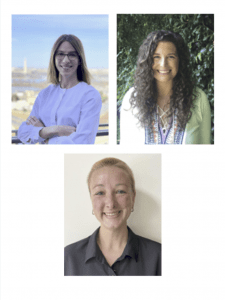Catherine O'Donnell, Elizabeth Mason, and Perrin Krisko make air quality monitoring accessible
Catherine O'Donnell, Elizabeth Mason, and Perrin Krisko first began working together in PUBH6435: Program Development and Implementation, in which they proposed an HIV intervention project in Kenya and all three received A's. After successfully working together and discovering a mutual desire to create sustainable change at the community level, they joined hands to propose a project even closer to their hearts; air quality.
Krisko, O'Donnell and Mason are all in the Milken School of Public Health, focusing on Global Health and are interested in ways to increase the accessibility of air quality monitoring, with the hopes of making improvements that will impact future generations. For their Knapp Fellowship, they created the Youth Air Quality Initiative and are exploring two central questions: How do hyperlocal quantitative air quality measurements compare to young peoples' knowledge and attitudes about air pollution in their urban communities? What is the experience of young people living at increased risk of air pollution?
To answer these questions, the team will collaborate with young people at the Latin American Youth Center (LAYC) to use portable air monitors and GPS devices to measure the air quality in Ward 1. In addition to collecting data, . they will spend time with the participants hearing their personal experiences with air quality in the neighborhood and compare their data collection with these personal histories. The Youth Air Quality Initiative believes it is critical for young people to be able to identify and address air pollution inequities in their communities in order to have agency over their environmental health. Young people must be equipped with not only knowledge, but the tools to be able to quantify the risks associated with air pollution in their communities. The resulting groundswell of community activism bolstered by quantitative data is what we propose to drive environmental stewardship and policy change.
The Youth Air Quality Initiative will equip students with analytical, geographical, and STEM skills necessary to identify, monster, analyze, and communicate neighborhood air pollution data and trends. Once the data is collected, participants will have the opportunity to present the data to local decision makers to inform environmental legislation in their community center and neighborhoods. These changes to environmental determinants of health may be realized by generations to come.
Some tips from the team:
1. Expect the unexpected. Projects never go as planned, and that’s the fun of it. Flexibility and adaptation are key to successful project planning and implementation, because during the course of the project, you will be introduced to new ideas and pathways that may help make the project even stronger!
2. 70% of project planning is communication. Making sure interested parties all have an equal say is integral to community-engaged partnerships. Communicating with your team is an asset, but it takes time to relay information so that everyone stays on the same page. In the long run, this will help assure that everyone has a stake in the project and feels invested in it. Communication is the key to project sustainability.
3. Know your ‘Why’ behind your project proposal. What differentiates the Knapp Fellowship from other fellowship opportunities is the emphasized balance between public service and academic engagement. Rooting your proposal in social justice, framed around your community partner’s needs, while tying in scholarship, is no easy task! Learn about the community you hope to serve to ensure that your proposal is thoughtful, necessary, and ultimately sustainable.
Learn more about the Knapp Fellowship for Entrepreneurial Service-Learning.


